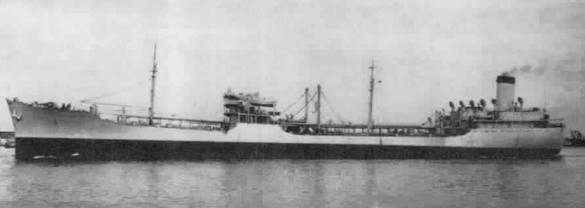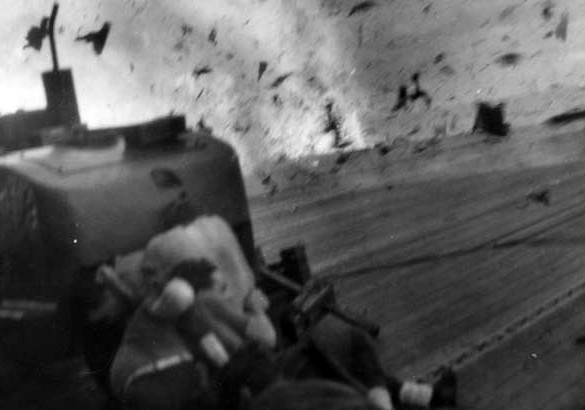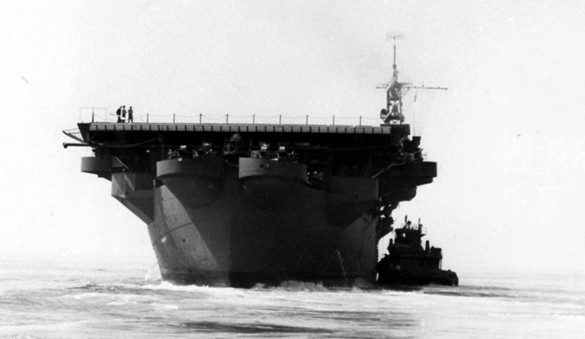August 09, 2009
The Best Of The Jeeps
Escort, or 'Jeep', carriers, were wartime conversions of merchant hulls. In 1942, as the US "auxiliary" carrier program spun up to full gear, every available C-3 hull, which was the preferred base design for conversion, had been earmarked for the Bogue-class escort carrier.
The Bogue-class was a relatively unsophisticated design, essentially slapping a flight deck on top of the hull, and changing the old main deck to a hangar. While effective, more hulls were desperately needed to escort convoys in the Atlantic and support operations in the Pacific. To overcome the shortfall, the powers-that-be tagged four T-3 tanker hulls for conversion.

The resulting Sangamon-class was considered the best of the converted Jeep carrier classes.

The Bogue-class was a relatively unsophisticated design, essentially slapping a flight deck on top of the hull, and changing the old main deck to a hangar. While effective, more hulls were desperately needed to escort convoys in the Atlantic and support operations in the Pacific. To overcome the shortfall, the powers-that-be tagged four T-3 tanker hulls for conversion.

T-3 Esso Trenton before conversion to USS Sangamon
The US Navy wasn't particularly fond of this idea. The one type of ship in even shorter supply than carriers were fast fleet oilers, designed to accompany warships and provide fuel and other supplies to short-legged ships in the vast ranges of the Pacific ocean, and the T-3 filled that bill. However, the Navy wasn't given a choice, and the four ships were taken into Norfolk Navy Yard, Newport News, Puget Sound Navy Yard and Bethlehem Steel.The resulting Sangamon-class was considered the best of the converted Jeep carrier classes.

USS Santee, CVE-29
Longer, heavier and faster than the preceding Bogue-class, and the basis for the subsequent purpose-built Casablanca-class (which was smaller and lighter, and just 1kt faster), the Sangamons could (and often did) carry 36 planes.
Unlike every other escort carrier class, the four Sangamons were able to embark any carrier plane in the Navy arsenal, save for the Helldiver and the Corsair. The usual air complement was between 12-18 Wildcats and around the same number of TBF Avengers, though the Sangamon and the Santee occasionally carried the Dauntless dive-bomber. The Suwannee and the Chenango never did, for one reason or another.
They displaced 24100 tons (full load), as opposed to 16600 tons for the Bogues. Unsurprisingly considering their tanker origins, they carried nearly three times as much fuel as well, giving them a range of 24000 nautical miles @ 15kts (the Bogues range was just over 10000nm). They also had a huge bunkerage for airplane fuel. As a matter of fact, they could carry more fuel than a Yorktown or Lexington-class fleet carrier, and only a bit less than the Essex-class, despite being about 350 feet shorter. In effect, the Sangamon-class were self-escorting tankers.
All four began their service life in late 1942, covering the North Africa landings of Operation Torch. Immediately following, they transferred to the Pacific. Three of the four were hit by kamikaze (the Chenango avoided that fate, but suffered severe damage when a F6F crash-landed on her deck and smashed into planes parked forward). The class as a whole suffered three kamikaze hits, four bomb strikes, and a submarine torpedo hit, yet all four survived... again, testament to the survivability of their larger-sized tanker origins.

The only thing that separated them from CVL status was their speed. 18kts maximum was pretty good for a transport, and excellent for an escort carrier, but much too slow to operate with the battle fleet, where 25-30kts was considered standard. That's about the only statistic that the Sangamons were inferior to the Independence-class CVL.
All four ships of the class survived the war, earning 41 battle stars between them. The Chenango and Santee continued in US Navy service as CVHEs (Carrier, Helicopter, Escort) until the late '50s. The Suwannee was put into the mothball fleet. The Sangamon, amusingly, was returned to commercial service in her original tanker configuration after the war, until she was scrapped in 1960.

Unlike every other escort carrier class, the four Sangamons were able to embark any carrier plane in the Navy arsenal, save for the Helldiver and the Corsair. The usual air complement was between 12-18 Wildcats and around the same number of TBF Avengers, though the Sangamon and the Santee occasionally carried the Dauntless dive-bomber. The Suwannee and the Chenango never did, for one reason or another.
They displaced 24100 tons (full load), as opposed to 16600 tons for the Bogues. Unsurprisingly considering their tanker origins, they carried nearly three times as much fuel as well, giving them a range of 24000 nautical miles @ 15kts (the Bogues range was just over 10000nm). They also had a huge bunkerage for airplane fuel. As a matter of fact, they could carry more fuel than a Yorktown or Lexington-class fleet carrier, and only a bit less than the Essex-class, despite being about 350 feet shorter. In effect, the Sangamon-class were self-escorting tankers.
All four began their service life in late 1942, covering the North Africa landings of Operation Torch. Immediately following, they transferred to the Pacific. Three of the four were hit by kamikaze (the Chenango avoided that fate, but suffered severe damage when a F6F crash-landed on her deck and smashed into planes parked forward). The class as a whole suffered three kamikaze hits, four bomb strikes, and a submarine torpedo hit, yet all four survived... again, testament to the survivability of their larger-sized tanker origins.

Santee takes a kamikaze hit
As with all ships in WWII, their AA guns were substantially increased from their starting armament. Unlike most others classes, however, the Sangamons handled the near-doubling of their guns without any topweight problems, owing to their tanker origins. The only thing that separated them from CVL status was their speed. 18kts maximum was pretty good for a transport, and excellent for an escort carrier, but much too slow to operate with the battle fleet, where 25-30kts was considered standard. That's about the only statistic that the Sangamons were inferior to the Independence-class CVL.
All four ships of the class survived the war, earning 41 battle stars between them. The Chenango and Santee continued in US Navy service as CVHEs (Carrier, Helicopter, Escort) until the late '50s. The Suwannee was put into the mothball fleet. The Sangamon, amusingly, was returned to commercial service in her original tanker configuration after the war, until she was scrapped in 1960.

The end of Sangamons.
For ships that were considered 'expendable', not a bad history.
Posted by: Wonderduck at
02:11 PM
| Comments (9)
| Add Comment
Post contains 660 words, total size 7 kb.
<< Page 1 of 1 >>
26kb generated in CPU 0.0131, elapsed 0.0844 seconds.
45 queries taking 0.0763 seconds, 168 records returned.
Powered by Minx 1.1.6c-pink.
45 queries taking 0.0763 seconds, 168 records returned.
Powered by Minx 1.1.6c-pink.









